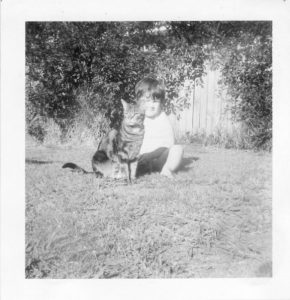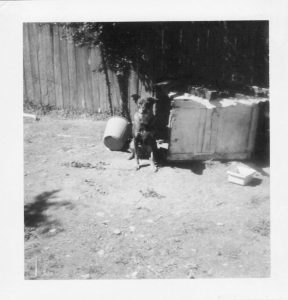It’s OK to rehome a pet
I “rescued” my first pet in the nineties. Before that, my family had acquired pets in a variety of different ways…

Old Puss (with me in around 1978) came to us from a FTGH ad, after a rigorous interview process
And departed from them in a variety of ways too.

Sheba was too much for our family & rehomed to the local Police Boys Club
Always an animal-loving family, somewhere in there I became aware of the RSPCA and started to buy into the world of animal welfare.
I started to believe all the stuff they said about responsible ownership. I started to hear about truly horrible things some truly horrible people did to animals. I started to believe people couldn’t be trusted. I started to believe that cruelty and neglect were pervasive. I started to believe that only a small group of people could be trusted to judge others worthy of pet ownership. Despite what my own familial experience taught me, and one of the few decent lessons from religion: thou shalt not judge.
It took a lot to change those beliefs and update my mindset. And I’m really sorry to anyone I ever judged so poorly.
Ideally, yes, you choose a pet and get to keep them forever. But if they are not a good fit, and could thrive in another home… The point is, it is rarely an easy decision, usually a heart-breaking one. Circumstances change. Stuff happens. Life can really be a big pile of bullshit sometimes.
So now I want to tell you: It’s OK to rehome a pet. It just is. The vast majority people are just trying to do their best. Honest.
If you find yourself in this position, it can be overwhelming. Your heart is breaking and you don’t know where to start… There’s a few options:
Return to source (breeder or rescue)
Depending on where you got your pet, this can be an easy option. At least having a conversation with their breeder/rescue can be a good place to start – especially if they have a waitlist for similar pets already.
Rehome yourself
In this case, I recommend writing a profile about your pet you can post on free classifieds, vet noticeboards, etc. It should focus on everything good about them to draw people in, and other information can be disclosed in a conversation with the person.
You do need to decide if you are going to charge – a fee is reasonable and can be a deterrent for alleged unscrupulous characters, but “free to good home” may be quicker. Free can attract unscrupulous people, though they rarely hold up in conversation or under questioning – remember genuine people may be nervous, so have a conversation! Free removes financial barriers to what could also be the perfect home.
You can of course ask around, friends, family, at the vet, as those that know your dog may indeed be interested – do just be mindful that especially at the vets, it’s something they may be asked a lot as they always make emotional investments in their patients.
You do need to be prepared to field questions, take interviews, however you want to run the process.
Once selected, you cannot second-guess where your pet is going – it helps to assume that anyone that took the time to apply will do their best for them, and then let them do that.
This can take time and is an emotional investment.
Rehome through a rescue group
(assisted rehoming where he stays with you or surrender to rescue in a foster situation)
This can be a good option as most rescue organisations have established advertising networks and may have waitlists (especially breed specific rescues).
Some rescues offer an “assisted rehoming” service where you keep your pet with you while they advertise them for you. Some rescues will help with questions & interviews, though you will likely still have to do all that yourself. There may be a fee associated with whatever level of service they offer.
Other rescues prefer to have the dog surrendered to them and put them into foster care. This means you sign over everything to them and have to trust their process. There may be a surrender fee associated with this, and it may take longer for them to be able to assist if there is no space in their foster carer network.
Both of these options can take time and have differing levels of emotional investment.
You have to be comfortable with the group you use. They all have basically the same ideals – to work to find the right match for animals that come to be in their care. They each tackle the task differently, with their own ethics & values, and some that have been at it for a while can easily suffer compassion fatigue that translates as being judgemental to both those seeking assistance and adopters, unfortunately. They are all trying their best, of course.
Surrender to a pound or shelter
I included shelters here because some organisations have shelters so do not rely solely on foster care networks, such as the RSPCA or AWL.
Depending on how many animals in care, may run a waitlist to surrender to them, and there may be a fee to do so.
A pound will likely have a surrender fee (possibly higher if not your local/contracted pound), but are usually “open intake”, so can take animals immediately. They can list them for immediate sale and hopefully they won’t stay long – whether sold directly to a new owner or placed with a rescue they partner with.
While the initial decision is still agonising, the pound is likely the quickest option with the least ongoing emotional investment.
Note: Some rescues, shelters, and pounds may ask seemingly intrusive questions about why you want to surrender. Some of them have outreach programs or try to connect people with services to determine if there is a way they can help you keep your dog, to keep him out of the system. It can feel confronting, especially when you have tried things like training already. I say this only to warn you, it’s STILL OK to rehome a dog.

Toby I picked from the litter of a BYB, photo by Sheryl Costin

Francine came from the RSPCA

Charlie was my first “rescue”, from a friend of my brother’s as a failed farm dog

Meesha was acquired by Mr Pawsonality under technically nefarious circumstances

 Previous Post
Previous Post Next Post
Next Post
